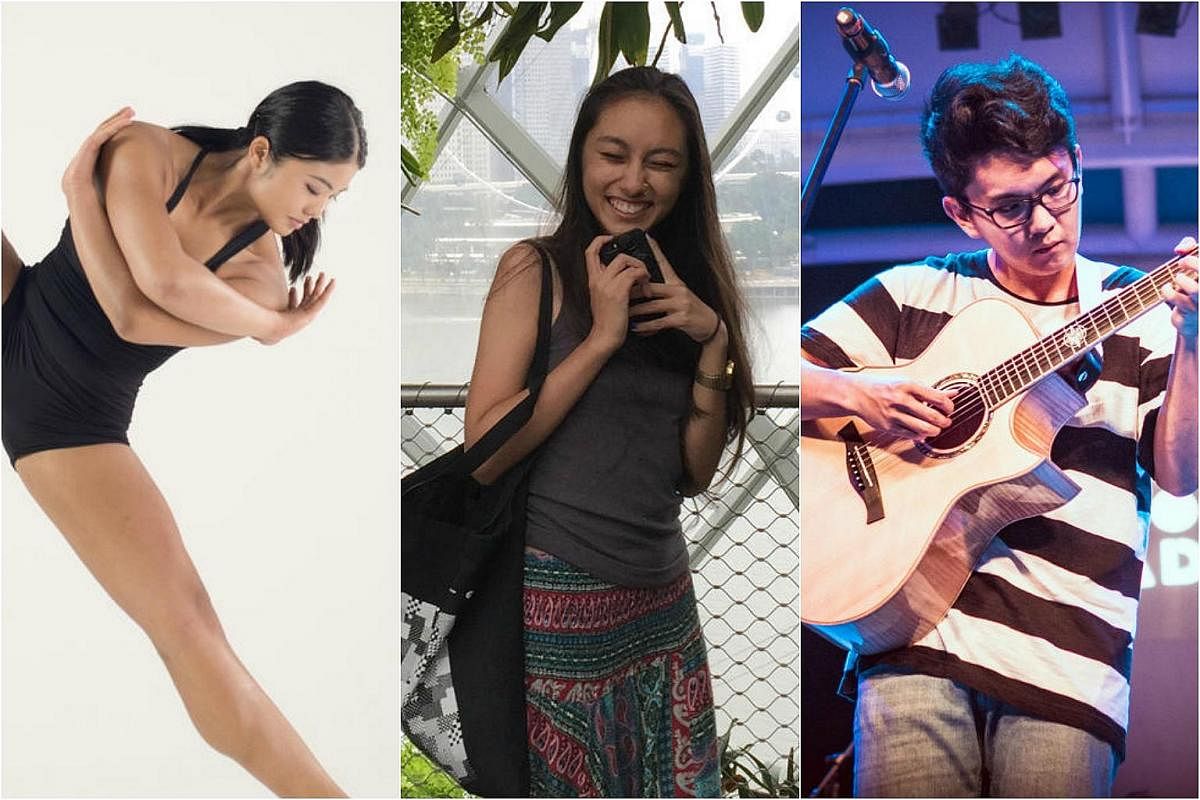Pioneer batches of Sota students enter the workforce
Some students from the pioneer batches of the School of the Arts (Sota) are now ready to take their next step in life

Before the School of the Arts (Sota) opened in 2008, some parents were worried about sending their children to the new arts school for youth aged 13 to 18.
Common questions raised: Would their kids have a good shot at getting into a university? Would they get a solid enough foundation in the sciences and mathematics? Would they be able to find a job?
Fast forward to the present and some students from Sota's early batches are beginning to enter the workforce.
Ms Yeo Chan Yee, 20, who specialised in dance, is now a ballet dancer with the Singapore Dance Theatre. Former film student Clare Chong, also 20, is now an independent film-maker whose works have been screened at events such as Singapore Short Cuts and Humanities Symposium Singapore. Visual arts alumna Joy Ho, 22, is an illustrator and recently finished a visual production internship with National Public Radio, a non-profit membership media organisation in the United States.
For Singapore's first specialised pre-tertiary arts school, this is reason to cheer.
Minister for Culture, Community and Youth Grace Fu told The Sunday Times that Sota has provided multiple pathways and varied career options for its arts students and graduates, including entry into renowned schools such as the Berklee College of Music, Royal Conservatoire of Scotland and Yong Siew Toh Conservatory of Music.
She says: "Besides identifying and nurturing future generations of artists, Sota is also grooming its students to be creative professionals who can be leaders in their respective fields and support the arts in their own personal capacities."
Despite parental concerns, the idea of attending an arts school proved popular right from the start.
More than 1,000 pupils reportedly auditioned for 300 slots in Year 1 and Year 2 for the school's first intake in 2008. Since then, an average of 800 applicants apply annually and the school takes in at most 200 students a year.
They take a six-year integrated arts and academic curriculum, leading to the International Baccalaureate (IB) diploma or the career-related programme.
They are taught academic subjects such as mathematics, science, the humanities and social sciences, and mother tongue languages. They can also specialise in one arts subject - dance, music, theatre, literary arts, visual arts or film.
Over the years, new programmes have been introduced. For example, film was introduced as a subject in 2012. Last year, literary arts was also introduced as a programme, under which students learn to write original poetry, prose and plays, among other creative texts.
Sota's principal, Ms Lim Geok Cheng, says: "We have always had a student-centred philosophy where we help our students achieve what they want to achieve, rather than tell them where they should go after graduation."
Over the last few years, she adds, the school has received an increase in the number of admission queries and a higher turnout at its open house and other outreach events.
It also has more collaboration opportunities with industry partners such as arts organisations and more of its students and alumni have received invitations to participate in exhibitions, projects and productions.
Of the five batches that have graduated, she adds, all have gone on to pursue tertiary studies except those in national service and the few who took a gap year.
But the school has also faced its share of challenges. Ms Lim says: "We have parents who think Sota students will all eventually become artists.
"Sota students have proven that they can excel in both the arts and academic subjects. Many have received offers to study arts- and non-arts related courses from prestigious universities and institutions of higher learning, as well as arts schools and conservatories."
Mr Alvin Tan, 54, founder and artistic director of home-grown theatre group The Necessary Stage, says: "So far, I strongly feel Sota has been successful.
"It has given young Singaporeans a headstart in developing their artistic gifts. It has also contributed to the credibility of the arts industry as a viable career option, sending a clear signal to Singaporeans that it is desirable and a serious profession."
When asked how Sota can improve, he suggests that it can have more active internships with theatre companies to introduce students to industry practice more thoroughly.
Referring to the school's theatre programme, he adds: "Once the students and parents are sure the students wish to pursue it as a life-long career, perhaps these students can also take on more theatre subjects and less normal school subjects."
She danced for British royal family

On the day of her audition for the School of the Arts, dancer Adelene Stanley had butterflies in her stomach and was constantly questioning if she was good enough to make the cut.
As part of the selection process, she had to attend a ballet class and a contemporary dance class with more than 20 other girls and she remembers three or four teachers sitting in front of the class, watching their every move.
"It was nerve-racking because dance is such a big part of my life. I wanted to get into Sota very badly, so I guess I placed a lot of pressure on myself. I was 12 then and it was my first experience going through a selection process for dance," she says.
That first audition gave her a taste of the many other auditions to come - for both dance schools and companies. "I was glad Sota had an audition process because that is the reality of a dancer's life," she says.
After years of auditions, long hours and gruelling schedules, the Sota alumna, now 21, has finally become what she always dreamt of - a professional dancer.
Last April, she became a full-time company artist with Frontier Danceland, a contemporary dance company in Singapore.
But her path has been a long one, starting from her first ballet class at the age of three and regular dance classes, once or twice a week, throughout primary school.
Her father, Mr L. Stanley Lall Singh, 61, manages a pest control business and her mother, Madam Susan Mok, 61, is a secretary in the same company. Her brother Arnold, 27, is an executive in an international chemical company; and her sister Amelia, 25, is a physiotherapist.
After primary school, Stanley spent four years as a student at Sota from 2008 to 2011 and this period, she says, taught her the fundamentals - self-discipline and a sense of ownership - which were needed to face the challenges ahead.
Training was tough. Academic classes started at 8am daily, she recalls. Once or twice a week, she stayed back in school until 7.30pm for dance practice.
But it was all worthwhile, as she was able to "grow creatively and develop under the watchful eye of experienced teachers". "It was a very cultivating experience and something I appreciate very much," she adds.
In 2011, she left Sota to pursue full-time dance training at the Rambert School of Ballet and Contemporary Dance in London with a scholarship from the National Arts Council.
After graduating with first class honours in 2014, she immediately started working and touring with London-based company Inala, performing in 57 shows in 25 different theatres and 21 cities.
That same year, she performed for the British royal family during the Royal Variety Performance, a televised variety show held annually in Britain.
The stages of Moscow and Scotland are also not foreign to her, as she has performed at the Chekhov International Theatre Festival and the Edinburgh International Festival.
And the energetic Stanley, who is in a relationship, shows no signs of stopping. She returned to Singapore to serve her two-year scholarship bond and now rehearses daily, choreographs pieces for Frontier Danceland's performances and teaches teenage students under the company's outreach programmes.
"I never want to stop learning. Every day, every process, is a learning experience that adds to my craft and work as a professional dancer."
Curiosity pushed her to start magazine

After completing Secondary 1 at Raffles Girls' School (RGS), Ms Ruby Thiagarajan, 23, decided to join the School of the Arts Singapore.
"I felt RGS had more of a sense of tradition and there was not as much space to experiment, both artistically and academically," she says.
As a theatre student at Sota, she says she was given a broad-based education that pushed her in all directions. From how to direct actors in a play to stage production, she was always encouraged to try a different approach.
And this curiosity and courage to experiment eventually led her to start her own magazine with some friends last year.
Titled Mynah Magazine, the annual print publication is dedicated to untold Singaporean stories through long-form journalism and creative non- fiction. Its first issue was published last October and is selling in stores such as BooksActually and Naiise at $28 a copy. So far, more than 800 of its 1,000-copy print-run have been sold.
The Singaporean says: "There are so many stories worth telling - those that lie forgotten at void decks, unnoticed in your phone's camera roll and stashed away in parts of the city that our transit lines still can't reach.
"We created Mynah because we really wanted a space for lengthy journalism dedicated to the aspects of Singapore that are just not as well known or discussed."
Her project has won support from home-grown writer Yu-Mei Balasingamchow and Singapore Literature Prize-winning author Joshua Ip, who contributed to the first issue. The team is currently looking for contributors for a second issue.
Ms Thiagarajan, who is single and now a social sciences undergraduate at Sciences Po, a university in France, says: "I'm just excited to contribute to the exploration of Singaporean culture in whatever way I can. I am quite inquisitive, a quality very much encouraged when I was in Sota."
Her mother, office manager Josephine Seah, 44, and father, retiree Raj Thiagarajan, 63, did have some initial reservations about sending their child to the new arts school. She has a brother, Rhys, 18, who just received his A-level results and is waiting to enlist in the army.
Ms Seah says that Ruby initially chose to go to RGS because she had attended Raffles Girls' Primary School and felt going to RGS was a natural progression.
Referring to Sota, she says: "We were not familiar with the International Baccalaureate curriculum and whether Ruby would have equal standing with students who took the A-level route to university in Singapore. Thankfully, she did not have trouble with this.
"In fact, the arts education has enriched Ruby's perspective of life and allowed her to mature and think deeper about her career path, role and contribution to society."
Music student just released an album

After completing his Primary School Leaving Examination, Bennett Bay had only one school in mind - the School of the Arts.
The 21-year-old Singaporean, who is classically trained in the suona, a Chinese wind instrument, says: "Had I not got in, I would have tried to get into another school with a good Chinese orchestra programme.
"I would still have been in the arts, but I probably wouldn't have been as content, or as free, as an artist."
He can also play the guitar and the oboe.
Looking back on his Sota days, the music student, who graduated in 2013, says his time in the school expanded his perspective towards music.
"I started playing the suona at age eight after my primary school teacher introduced me to it. I assumed I would eventually join a professional Chinese orchestra," he says. "But in school, I was exposed to other forms of music, such as Gregorian chant, atonal music and even punk and metal. I learnt to consider other possibilities."
While serving national service, he started writing songs and performed some of them at a free show at the Esplanade concourse in 2015.
That gig led to more performances and more songwriting and culminated in the release of his first full-length album, titled Compass, last month.
The 13-track album of folk songs tells a story about a lost child torn between finding his way back home or settling for the unknown.
It is for sale at $12 (digital download) on iTunes.
The Straits Times music reviewer Eddino Abdul Hadi described Bay's voice as "gentle and soothing" and some of the tracks as "bucolic, stripped-down guitar pieces that conjure the idyllic beauty of the countryside".
Bay, currently in his first year of a bachelor of arts (honours) music programme at Lasalle College of the Arts, specialising in jazz performance, says: "I'm focusing on jazz for now because I'm trying to expand my boundaries."
The bachelor counts post-rock bands Explosions In The Sky and Sigur Ros as his inspirations.
In the coming months, he will start work on this second album, titled In Memory Of, which will have more of a rock feel.
His father, retiree Bay Sieu Boon, 68, says: "It was my son's decision to go to Sota to take up music. I had no objection because we noticed he has some talent in music and it's better to let him study something that he likes.
"As for his career, it's hard to say right now as he's still young and is still making a name for himself."
His mother, Madam Helen Ong, 58, works in a childcare centre. His sister Lynette, 19, just graduated from Sota and is waiting for admission to a local university.
"I hope to continue writing music and performing it," says Bay. "Music has become my main outlet for understanding the world and myself. Eventually, I want to perform overseas and take my ideas outside Singapore.
"Perhaps there are communities outside of Singapore that can relate to music from our small island and we can better understand one another's culture," he adds
Join ST's Telegram channel and get the latest breaking news delivered to you.
A version of this article appeared in the print edition of The Sunday Times on February 26, 2017, with the headline Pioneer batches of Sota students enter the workforce. Subscribe

